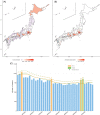Geographically weighted generalized Farrington algorithm for rapid outbreak detection over short data accumulation periods
- PMID: 34491590
- PMCID: PMC9292201
- DOI: 10.1002/sim.9182
Geographically weighted generalized Farrington algorithm for rapid outbreak detection over short data accumulation periods
Abstract
The demand for rapid surveillance and early detection of local outbreaks has been growing recently. The rapid surveillance can select timely and appropriate interventions toward controlling the spread of emerging infectious diseases, such as the coronavirus disease 2019 (COVID-19). The Farrington algorithm was originally proposed by Farrington et al (1996), extended by Noufaily et al (2012), and is commonly used to estimate excess death. However, one of the major challenges in implementing this algorithm is the lack of historical information required to train it, especially for emerging diseases. Without sufficient training data the estimation/prediction accuracy of this algorithm can suffer leading to poor outbreak detection. We propose a new statistical algorithm-the geographically weighted generalized Farrington (GWGF) algorithm-by incorporating both geographically varying and geographically invariant covariates, as well as geographical information to analyze time series count data sampled from a spatially correlated process for estimating excess death. The algorithm is a type of local quasi-likelihood-based regression with geographical weights and is designed to achieve a stable detection of outbreaks even when the number of time points is small. We validate the outbreak detection performance by using extensive numerical experiments and real-data analysis in Japan during COVID-19 pandemic. We show that the GWGF algorithm succeeds in improving recall without reducing the level of precision compared with the conventional Farrington algorithm.
Keywords: emerging infectious disease; geographically weighted quasi-Poisson regression; outbreak detection; statistical surveillance.
© 2021 The Authors. Statistics in Medicine published by John Wiley & Sons Ltd.
Conflict of interest statement
The authors declare no potential conflict of interest.
Figures


Similar articles
-
Outbreak detection algorithms based on generalized linear model: a review with new practical examples.BMC Med Res Methodol. 2023 Oct 14;23(1):235. doi: 10.1186/s12874-023-02050-z. BMC Med Res Methodol. 2023. PMID: 37838735 Free PMC article. Review.
-
A statistical algorithm for outbreak detection in multisite settings: an application to sick leave monitoring.Bioinform Adv. 2023 Jun 14;3(1):vbad079. doi: 10.1093/bioadv/vbad079. eCollection 2023. Bioinform Adv. 2023. PMID: 37521307 Free PMC article.
-
Detecting early signals of COVID-19 outbreaks in 2020 in small areas by monitoring healthcare utilisation databases: first lessons learned from the Italian Alert_CoV project.Euro Surveill. 2023 Jan;28(1):2200366. doi: 10.2807/1560-7917.ES.2023.28.1.2200366. Euro Surveill. 2023. PMID: 36695448 Free PMC article.
-
Effectiveness and cost-effectiveness of four different strategies for SARS-CoV-2 surveillance in the general population (CoV-Surv Study): a structured summary of a study protocol for a cluster-randomised, two-factorial controlled trial.Trials. 2021 Jan 8;22(1):39. doi: 10.1186/s13063-020-04982-z. Trials. 2021. PMID: 33419461 Free PMC article.
-
The Novel Coronavirus: A Bird's Eye View.Int J Occup Environ Med. 2020 Apr;11(2):65-71. doi: 10.15171/ijoem.2020.1921. Epub 2020 Feb 5. Int J Occup Environ Med. 2020. PMID: 32020915 Free PMC article. Review.
Cited by
-
Changes in Place of Death Among Patients With Dementia During the COVID-19 Pandemic in Japan: A Time-series Analysis.J Epidemiol. 2024 Oct 5;34(10):493-497. doi: 10.2188/jea.JE20230279. Epub 2024 May 31. J Epidemiol. 2024. PMID: 38403690 Free PMC article.
-
Spatio-temporal surveillance and early detection of SARS-CoV-2 variants of concern: a retrospective analysis.J R Soc Interface. 2023 Nov;20(208):20230410. doi: 10.1098/rsif.2023.0410. Epub 2023 Nov 15. J R Soc Interface. 2023. PMID: 37963560 Free PMC article.
-
Outbreak detection algorithms based on generalized linear model: a review with new practical examples.BMC Med Res Methodol. 2023 Oct 14;23(1):235. doi: 10.1186/s12874-023-02050-z. BMC Med Res Methodol. 2023. PMID: 37838735 Free PMC article. Review.
-
A statistical algorithm for outbreak detection in multisite settings: an application to sick leave monitoring.Bioinform Adv. 2023 Jun 14;3(1):vbad079. doi: 10.1093/bioadv/vbad079. eCollection 2023. Bioinform Adv. 2023. PMID: 37521307 Free PMC article.
-
Estimating Overall and Cause-Specific Excess Mortality during the COVID-19 Pandemic: Methodological Approaches Compared.Int J Environ Res Public Health. 2023 May 24;20(11):5941. doi: 10.3390/ijerph20115941. Int J Environ Res Public Health. 2023. PMID: 37297545 Free PMC article.
References
-
- Farrington P, Andrews N. Application to infectious. Ron Brookmeyer, Donna Stroup, Monitoring the Health of Populations: Statistical Principles and Methods for Public Health Surveillance; UK: Oxford University Press; 2003:203.
-
- Unkel S, Farrington CP, Garthwaite PH, Robertson C, Andrews N. Statistical methods for the prospective detection of infectious disease outbreaks: a review. J Royal Stat Soc Ser A (Stat Soc). 2012;175(1):49‐82.
-
- Shmueli G, Burkom H. Statistical challenges facing early outbreak detection in biosurveillance. Technometrics. 2010;52(1):39‐51.
-
- Buckeridge DL, Burkom H, Campbell M, Hogan WR, Moore AW, et al. Algorithms for rapid outbreak detection: a research synthesis. J Biomed Inform. 2005;38(2):99‐113. - PubMed
-
- Sonesson C, Bock D. A review and discussion of prospective statistical surveillance in public health. J Royal Stat Soc Ser A (Stat Soc). 2003;166(1):5‐21.
Publication types
MeSH terms
Grants and funding
LinkOut - more resources
Full Text Sources
Medical
